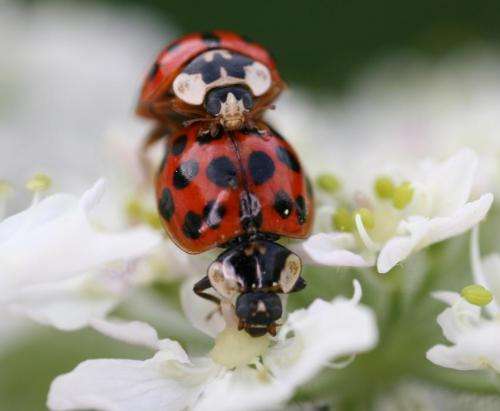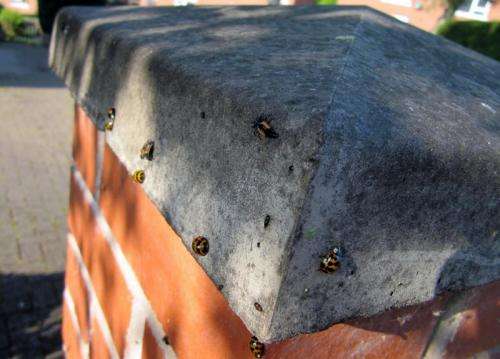City life key to harlequin ladybird invasion

A new paper published in the Journal of Biogeography today concludes that the harlequin ladybird, an invasive alien species first recorded in the UK in 2004, has a preference for urban areas and sunnier habitats.
By establishing rapidly in cities and urban areas, and overwintering inside buildings, the harlequin has outcompeted native ladybird species which have suffered from the combined negative impacts of habitat deterioration and competition from the invasive alien.
The new study, led by scientists from the Centre for Ecology & Hydrology working with the Universities of Edinburgh, Anglia Ruskin, and Reading, sought to understand the effect of both landscape and climactic factors on the spread of this ladybird. It used records from citizen scientists who submitted around 23,000 sightings to the UK Ladybird Survey between 2003 and 2011.
While previous research on the same dataset had primarily focused on the effect of its phenotypic traits, such as its broad diet and high reproduction rate, the new study compared sightings with spatial survival models in order to identify where the ladybird might appear next. Spatial survival analysis has been widely applied in disease epidemiology but rarely applied to explore the spread of invasive alien species.
Lead author Dr Bethan Purse from the Centre for Ecology & Hydrology said, "Our new study indicates that environmental factors, particularly habitat, have made some areas of Britain such as cities more vulnerable to rapid invasion of the harlequin ladybird than other areas, even after recording intensity and proximity to initial invasion sites are accounted for."

The scientists also looked at whether colour patterns – the harlequin has a wide range – could be used to explain different invasion speeds.
Dr Purse added, "There are strikingly different colour forms of the harlequin ladybird from the orange with black spots to black with red spots. We found some evidence that climate factors influenced the speed of spread of the different colour morphs in slightly different ways."
Co-author Dr Helen Roy from the Centre for Ecology & Hydrology said, "This study demonstrates the value of a citizen science approach for tracking an invasive alien species in both space and time and understanding how environmental conditions may exacerbate spread."
Dr Roy added, "The UK Ladybird Survey provides a fantastic resource for understanding invasion processes, with records of the harlequin, including detailed observations on colour form, from tens of thousands of people across the country since the moment of first invasion.
The results also show that harlequin ladybird have struggled to spread into coniferous woodland. A number of ladybird species within Britain are largely confined to coniferous woodland and it appears that such habitats are more resistant to invasion by the harlequin ladybird than other habitats.
Dr Roy added, "Coniferous woodland could potentially provide a refuge for some native ladybirds which would otherwise be threatened by the harlequin ladybird."
Journal information: Journal of Biogeography
Provided by Centre for Ecology & Hydrology


















